This post may contain affiliate links. Please see our disclosure policy.
Zucchini relish one of my favorite ways to use up zucchini from the garden. Considerably more flavorful than straight dill pickle relish, homemade zucchini relish is a real hit at summer barbeques.
When this zucchini relish is made as a canning recipe, you can preserve zucchini right on the pantry shelf for year-round eating. It’s also perfectly fine to make a small batch for the refrigerator, and it’ll last for several months so you can enjoy it all summer long.
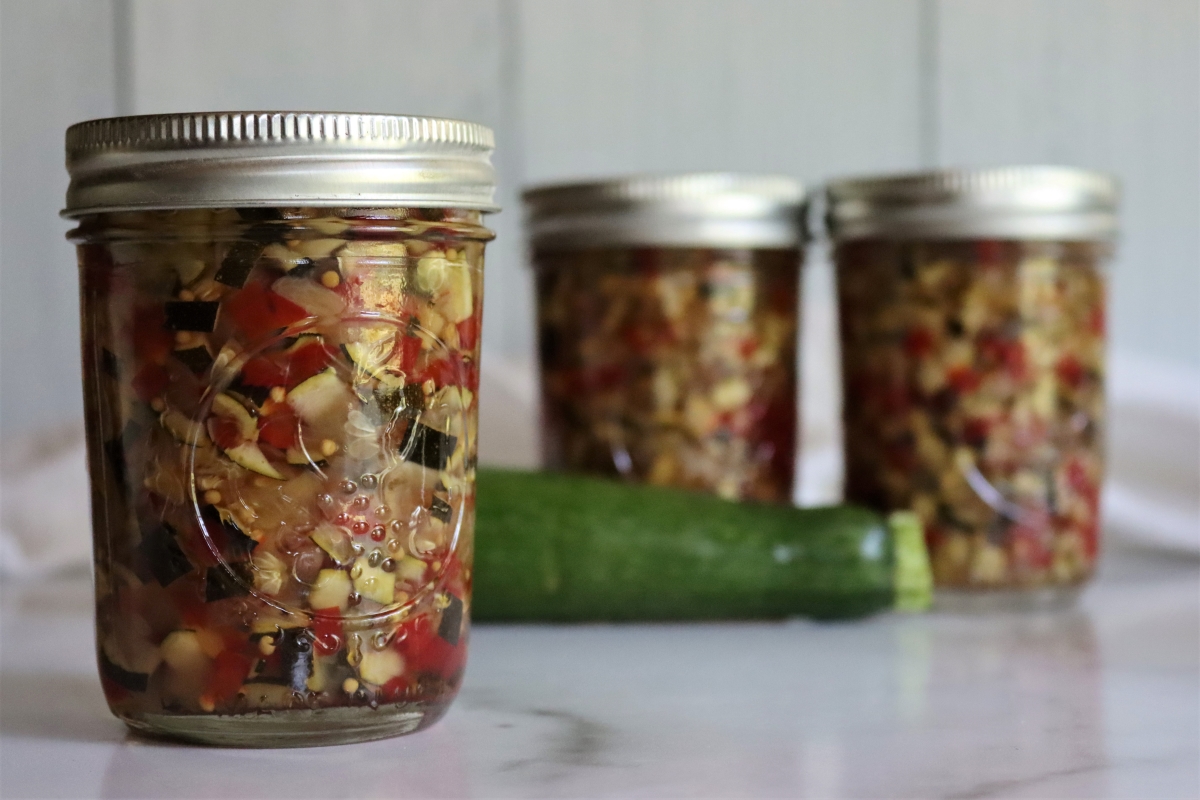
Every gardener knows what happens when you grow zucchini…
It starts out slow, with just a few tiny squash and you add them to dinner as a quick side dish. Then they start to come in by the bucket load, and you make zucchini bread for the whole neighborhood.
Then you’re carrying bags of zucchini to neighbors, begging them to take them off your hands.
You get desperate and start grating and freezing zucchini for winter baking, but the freezer fills up.
Then you really start to pannic.
Ok, well maybe it’s not all that bad. But it’s still always good to know a few good ways to use up extra zucchini, especially if they don’t require precious freezer space.
This simple zucchini relish is on of my favorite zucchini canning recipes, and it’s bright, festive, and incredibly tasty.
A bit of red pepper adds color, while onion and whole mustard seed gives it a pleasant crunch.
Don’t worry, it’s still mostly zucchini, so you can make a couple of batches to use up those extra squash on the counter.
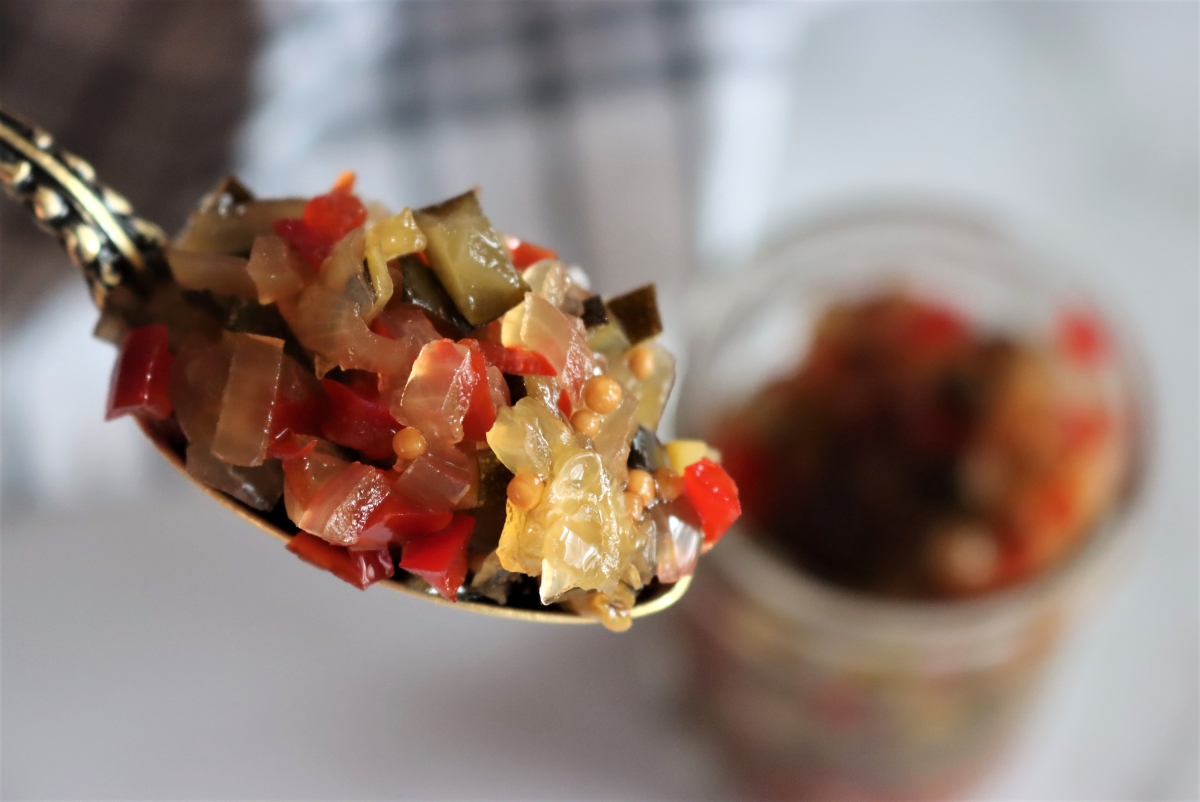
This recipe for Zucchini Relish is adapted from The Ball Blue Book Guide to Preserving, which has literally hundreds of safe, tested canning recipes.
Ingredients for Zucchini Relish
Relish is one of those condiments we eat with our eyes as much as our mouths, and adding a variety of colors and textures is key to a good relish recipe.
Of course, in a zucchini relish recipe, part of the goal is to use up as much zucchini as possible. The problem is, zucchini tends to fall apart and get soggy during canning, especially when diced finely.
Using no more than half zucchini ensures good texture, but also allows you to incorporate other colors and flavors into the finished relish.
The vegetables in this relish include two parts zucchini, and then one part each diced onion and diced red pepper.
To yield about 4 half-pints (8 oz) jars, you’ll need:
- 2 cups zucchini, diced (about 3 medium)
- 1 cup onion, diced (about 1 medium)
- 1 cup red bell pepper, diced (about 2 small or 1 large)
- 2 Tablespoons Salt (pickling and canning salt, or kosher salt)
- 1 3/4 cups sugar
- 2 teaspoons celery seed (whole)
- 1 teaspoon mustard seed (whole)
- 1 cup cider vinegar (5% acidity)
- Pickle Crisp Granules (optional, helps veggies stay firm after canning)
This is a tested canning recipe, and you should not change the total amount of vegetables (or the proportions), and you cannot reduce the total amount of vinegar.
That said, the salt, sugar, and spices are for flavor/texture and are not what makes this a safe canning recipe. Feel to skip the spices, or replace them with others that are more suited to your tastes.
You can also reduce the salt or sugar, but know that they are calculated to balance the acidity in the recipe and create a well-rounded relish. Reducing them will also negatively impact the texture of the finished relish.
While in most canning recipes you can use sodium-free salt substitutes, I wouldn’t recommend it for this zucchini relish. The salt is used to soak the vegetables before making the relish, and it is what’s responsible for keeping the diced veggies firm during canning. Most of it is rinsed out before actually making the relish.
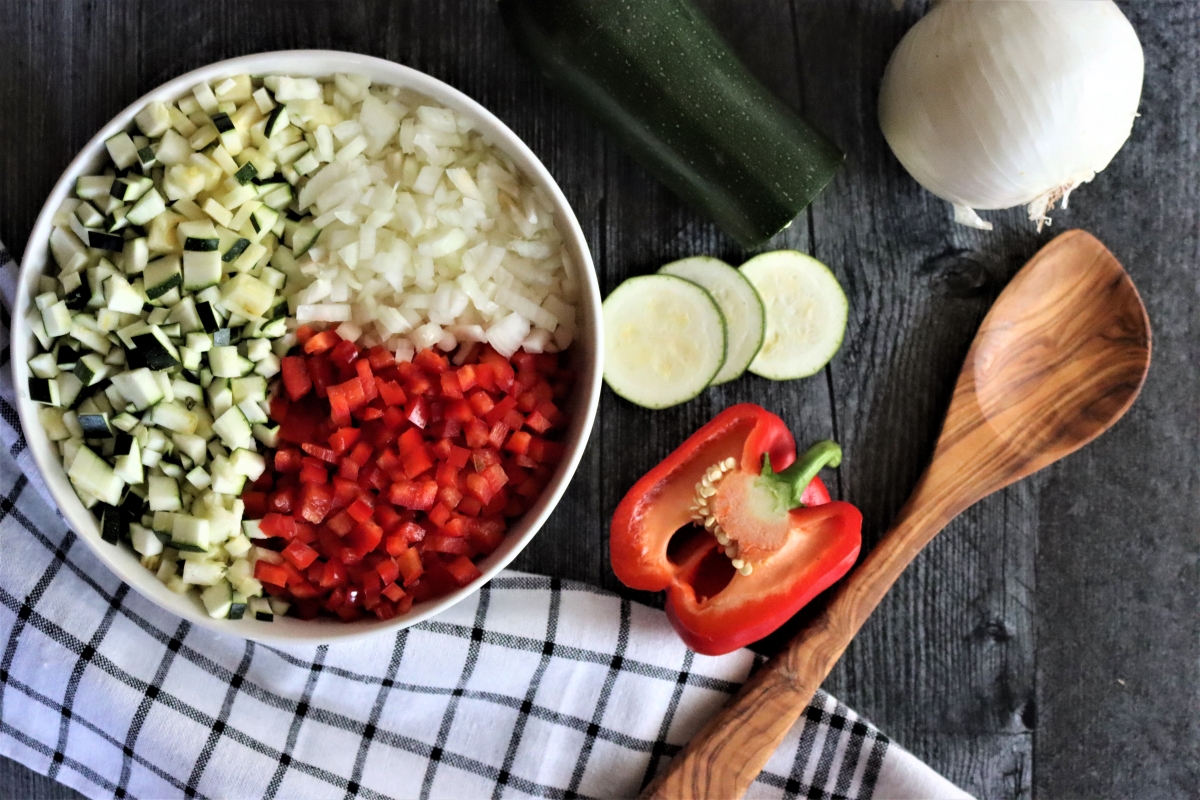
How to Make Zucchini Relish
Making zucchini relish starts with washing and then dicing the vegetables. Try for consistent size, right around 1/4 to 1/2 inch dice.
After dicing, this is the important part, so pay attention:
Combine diced zucchini, onion, and red bell pepper in a large bowl. Sprinkle 2 tablespoons of pickling/canning salt over the veggies, and gently stir with your hands to evenly distribute the salt. Then, add water until the veggies are completely submerged.
Allow the veggies to stand in the saltwater for 2 hours, then drain.
This causes the veggies to lose liquid and firms them up so that they stay intact during canning.
It also infuses the salt into the vegetables, but then allows most of it to drain away. Two tablespoons is a lot of salt across just 4 half-pint jars, but most of it will drain away with the water, leaving the finished zucchini relish just right.
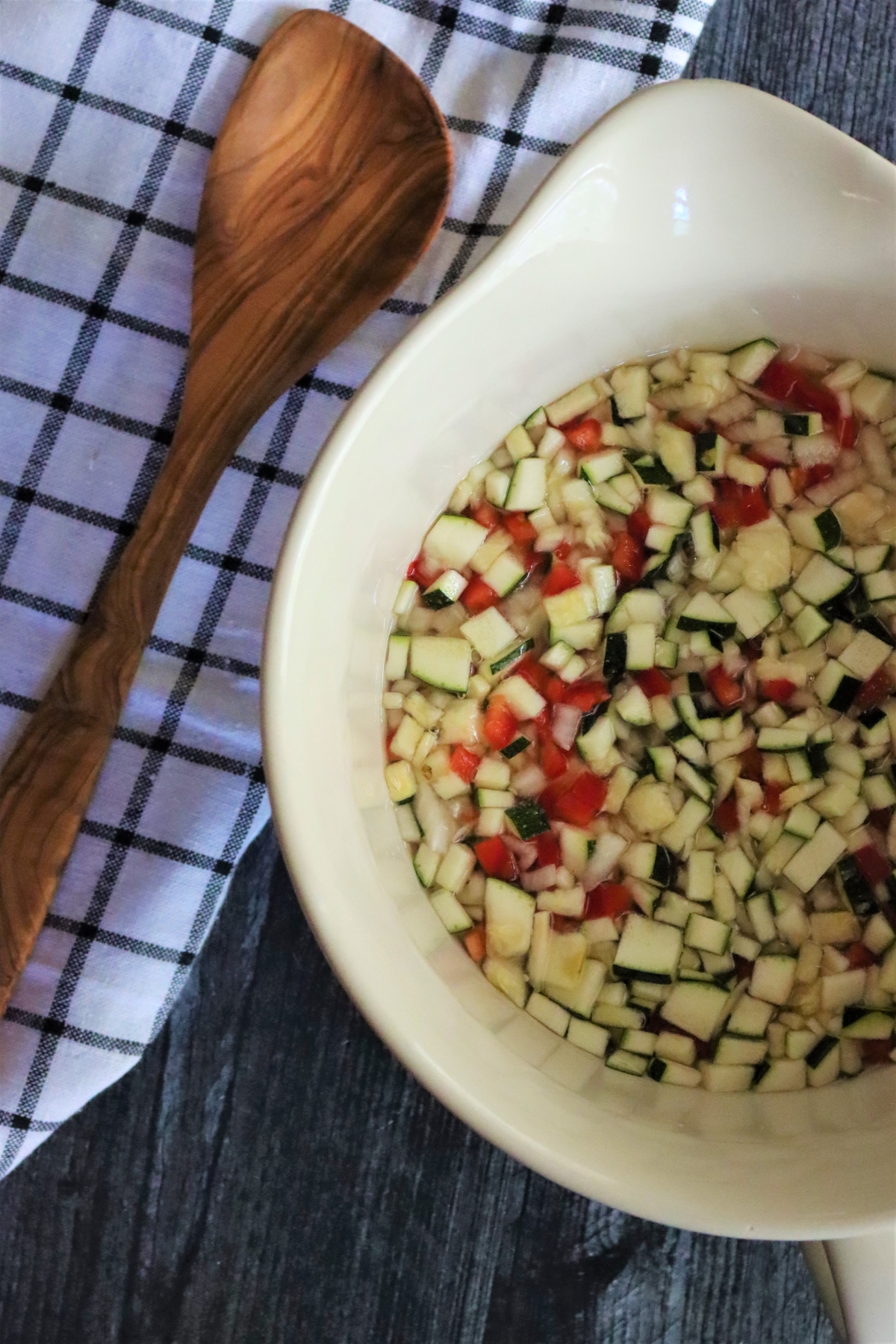
After the veggies have soaked in saltwater and then drained, prepare a water bath canner (if canning).
In a separate pot, combine sugar, spices, and vinegar.
Bring the mixture to a simmer (180 degrees F), and add the soaked/drained veggies. Simmer gently for 10 minutes until the vegetables are completely heated and cooked.
Pack the hot relish into prepared jars, leaving 1/2 inch headspace.
Add 1/16 tsp pickle crisp to each half-pint jar (or 1/8 tsp per pint jar), if using. Pickle crisp is optional, but it helps keep the veggies firm after canning. It’s all-natural, just calcium chloride, which firms up the cell walls of the veggies.
(Pickle crisp, as the name implies, also works great for homemade pickles, not just relish.)
The finished relish should hold up well on a spoon, and the bright colors will add a festive look to just about anything.
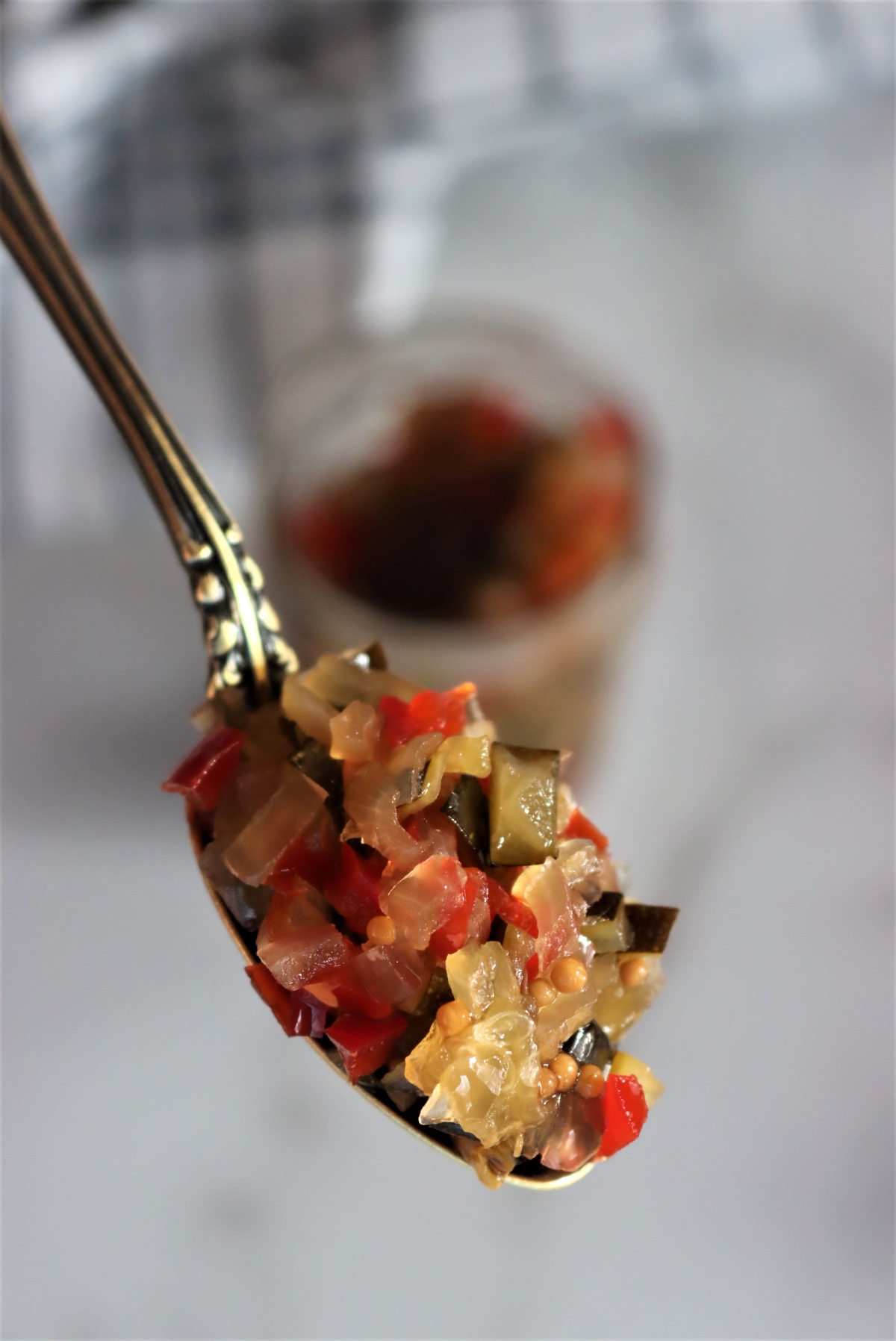
Canning Zucchini Relish
It’s perfectly fine to make zucchini relish as a refrigerator recipe, canning is not required.
For refrigerator zucchini relish, simply cap the jars and then allow them to cool to room temperature before storing in the refrigerator. They should keep several weeks (possibly several months) in the refrigerator, as the acid from the vinegar is really good and preserving vegetables even without canning.
That said, water bath canning is incredibly simple, and allows you to store the relish on the pantry shelf until it’s needed. Refrigerator space is always scarce in my house, especially in the busy summer months when the garden’s bounty is coming ripe all at once.
To can zucchini relish, fill the jars with hot relish leaving 1/2 inch headspace. Wipe rims, de-bubble jars, and adjust headspace before capping with 2 part canning lids.
Process in a water bath canner for 10 minutes. Once the processing time is complete, turn off the heat but don’t remove the jars yet.
Allow the jars to sit for another 5 minutes in the canner before removing them to cool on a towel on the counter. This extra 5 minutes allows the jars to cool slightly before they’re removed from the canner, which in turn helps prevent siphoning (or liquid loss due to thermal shock as the jars are removed).
Leave the jars undisturbed for 24 hours, then check seals. Store any unsealed jars in the refrigerator for immediate use. Sealed jars should maintain peak quality on the pantry shelf for 12-18 months. Refrigerate after opening.

Ways to Preserve Zucchini
Looking for more ways to preserve a bumper crop of zucchini?
- Freezing Zucchini
- Zucchini Marmalade
- Zucchini Canning Recipes
- Grated Zucchini Kraut (Preserved Using Lacto-Fermentation)
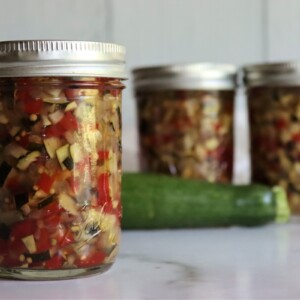
Zucchini Relish Recipe for Canning
Equipment
Ingredients
- 2 cups zucchini, diced (about 3 medium)
- 1 cup onion, diced (about 1 medium)
- 1 cup red bell pepper, diced (about 2 small or 1 large)
- 2 Tbsp salt, pickling and canning salt, or kosher salt
- 1 3/4 cup sugar
- 2 tsp celery seed, whole
- 1 tsp mustard seed, whole
- 1 cup cider vinegar, 5% acidity
- Pickle Crisp Granules, optional, helps veggies stay firm after canning
Instructions
- Wash vegetables.
- Remove stem and blossom ends from zucchini and dice into 1/4 to 1/2 inch pieces. Measure 2 cups.
- Peel and dice onion. Measure 1 cup.
- Stem and seed peppers, then dice. Measure 1 cup.
- Important, don't skip this step! Combine diced vegetables in a large bowl and sprinkle salt over the top. Stir gently to distribute the salt, then add water until vegetables are completely submerged. Allow the vegetables to soak in the saltwater for 2 hours, then drain completely.
- Prepare a water bath canner (optional, only if canning).
- In a separate saucepan or stockpot, bring vinegar, sugar, and spices to a gentle simmer (180 degrees F). Do not add salt, the salt is only used to soak veggies before draining.
- Add drained vegetables to the simmering vinegar/spices and gently simmer for 10 minutes.
- Pack hot relish into prepared half-pint or pint jars, leaving 1/2 inch headspace.
- If not canning, just seal jars and allow them to cool on the counter before storing in the refrigerator.
- If canning, de-bubble jars, wipe rims, and adjust headspace to ensure 1/2 inch. Seal with 2 part canning lids.
- Process in a water bath canner for 10 minutes, then turn off the heat. Allow the jars to sit in the canner for another 5 minutes to cool slightly, then remove the jars to cool on a towel on the counter.
- Leave the jars undisturbed for 24 hours, then check seals. Store any unsealed jars in the refrigerator for immediate use. Properly canned and sealed jars should maintain peak quality on the pantry shelf for
12-18 months.
Notes
Nutrition
Nutrition information is automatically calculated, so should only be used as an approximation.
Pickle Recipes for Canning
These easy water bath canning recipes make tasty homemade pickles (and relish too)!
- Classic Dill Pickles
- Bread and Butter Pickles
- Gherkins (Baby Pickles)
- Dill Pickle Relish
- Pickled Garlic
- Pickled Carrots
- Pickled Beets
Summer Canning Recipes
Putting up more than pickles this season?
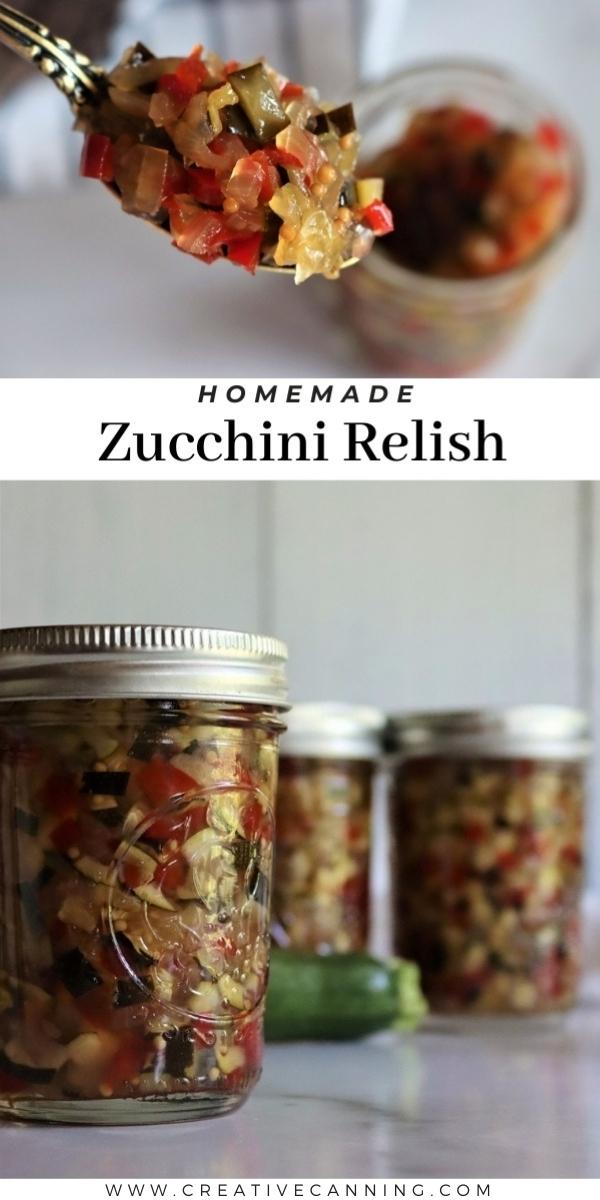
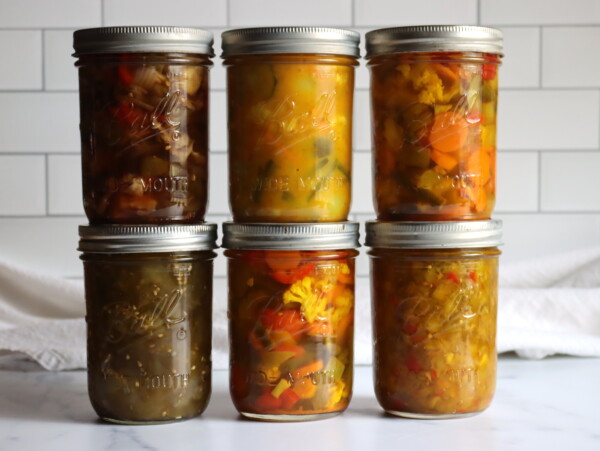
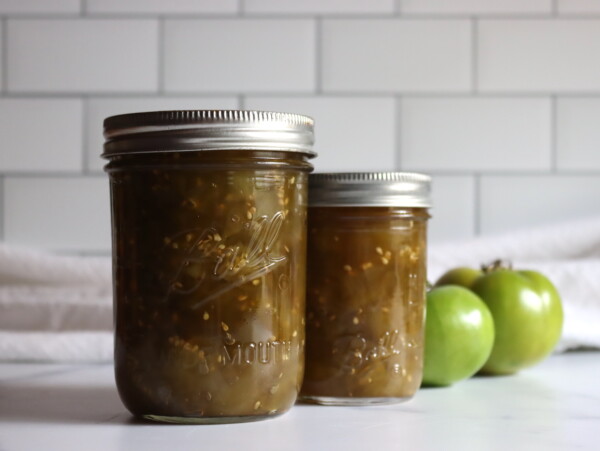

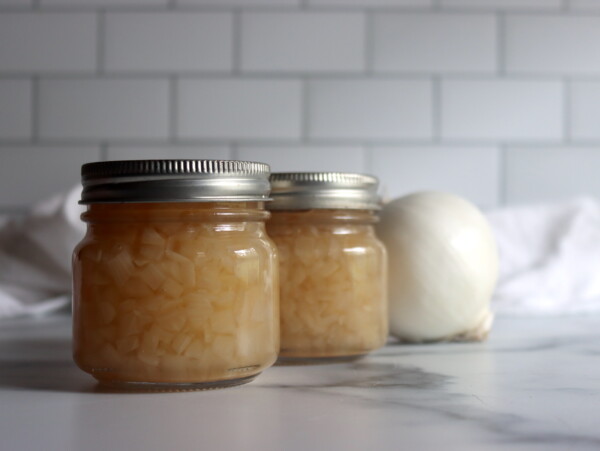
This is absolutely delicious
So good i had to make a second batch
100 stars
Lovely!
This is so delicious…best relish I have even had! Will be making this again very soon. My entire family loves it and I cannot keep in it.
So glad you liked it!
Can I shred the zucchini instead of cutting into 1/4 or half inch?
Yes, that’s fine, just make sure you’re able to mix it into the vinegar thoroughly and that there’s not a matted mass of it that’s not exposed to vinegar.
This relish sounds pretty straight forward and tasty.
Could a grape leaf be used in each jar instead of Pickle Crisp to try and keep some crunchiness in the veggies?
Yup!
Is it necessary to cook the relish in the brine? Or can I just put the relish in the jars and cover with hot brine like pickles?
This recipe has been tested by first cooking the relish in the brine so I would recommend following those instructions.